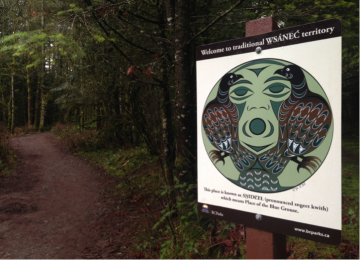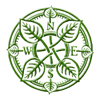
Walking along the well-established trails toward Tod Inlet in Central Saanich gives an air of relatively untouched beauty. The call of a Northwestern crow resonates from afar, and the twitter of many Anna's hummingbirds and varied thrushes can be heard amongst the brush. Beyond this initial glimpse of a seemingly natural place, the woods, creek, and ocean whisper secrets of their past – a past thick with elements of colonialism, racism, and environmental degradation.
At the Tod Inlet trailhead a sign welcomes visitors to SṈIDȻEȽ (pronounced sngeet-kwith), a traditional place used by the W̱SÁNEĆ (Saanich) First Nation. In the SENĆOŦEN (sen-cho-then) language, SṈIDȻEȽ means “place of the Blue Grouse” To the W̱SÁNEĆ nation, the Blue Grouse species signified that the land at SṈIDȻEȽ was plentiful. The area was indeed, and still is, an important resource for edible and medicinal plants used by the Nation (Seachange Marine Conservation Society, n.d.). Beyond the sign at the entrance, traces of the traditional use of the land are harder to find. Culturally modified trees dot the edges of the trail; specimens of Western red cedar stand tall with scars of harvest in their bark.
Remnants of other cultures’ uses of the land are easier to spot. Near the trailhead, the sound of Tod Creek’s waters rumble as they are thrown over a small dam. The dam is a reminder of Tod Inlet’s industrial past. The Butchart family purchased the limestone-rich land near the shores of the inlet in the early 1900s. 1904 marked the establishment of Robert Butchart’s Vancouver Portland Cement Company – the first cement company west of the Great Lakes (Bamberton Historical Society, n.d.). Quarrying continued until 1912 when the land was exhausted, and business moved across the Saanich Inlet to Bamberton (Bamberton Historical Society, n.d.). The modern place name “Tod Inlet” is a reflection of this time when European colonialists were settling the Greater Victoria area; the inlet was named after John Tod, an employee of the Hudson’s Bay Company (Dictionary of Canadian Biography, 1982). Fragments of the Vancouver Portland Cement Company’s employees’ lives are scattered throughout the area. Cement foundations, and discarded bricks along the banks of the inlet are prominent features of the landscape, as well as a “garbage dump” of sorts from the men who once worked there.
The Village at Tod Inlet
The advent of this lucrative heavy industry meant that many settlers came to the area for employment. A diverse community of Canadians, Europeans, and dozens of labourers from India and China now called Tod Inlet their home (Gray, 2011). The aforementioned garbage dump contains littered remains of teacups, medicine bottles, and leather boots, providing a glimpse into the less celebrated history of the Vancouver Portland Cement Company. These remains are less likely to be remnants of the European settlers – who were given family housing upon employment – and more likely to belong to the Chinese and Sikh labourers who worked for the Butchart’s company. Not only were they paid less than their white counterparts, they were not provided housing and thus constructed their own shantytowns. Furthermore, racist laws of the time including the Chinese Head Tax and the Continuous Journey regulation restricted these men from bringing their families to Canada with them (Gray, 2011). The intriguing documentary included in this story, titled Beyond the Gardens’ Wall, sheds light on the erased history of these immigrants and their legacy that lives on within the Capital Regional District.
Beyond the work in the cement quarries, life at Tod Inlet was quiet for settlers. According to Joyce Jacobsen (née Carrier), who grew up at the Tod Inlet village in the 20s and 30s “everything moved at a slower pace”. Her family lived in the old Manager’s house at Tod Inlet, and her days growing up were spent swimming, playing tennis, strawberry picking, and attending the since closed Mt. Newton High School. In an autobiographical letter detailing her time growing up in the area, Joyce recalls a fantastic array of adventures she embarked on with both friends and family. The letter illustrates a picturesque and quieter time in the Capital Regional District, from learning how to skate on the rarely frozen Tod Inlet, to witnessing the filming of the Country Western picture Stampede. A transcription of Joyce’s full letter can be read here.
SṈIDȻEȽ After Its Industrial Age
Upon the abandonment of the quarry, Jennie Butchart set out to beautify the bare landscape, and planted what is now known as the Sunken Garden. Over time, more themed gardens were built on the Butchart property, and the family opened their home to visitors. Some of the staff who tended the garden were previous labourers of the Tod Inlet cement factory. The gardens are still owned and operated by the Butchart family, and as of 2004, the destination is recognized as a National Historic Site. It welcomes just shy of a million visitors every year (The Butchart Gardens, 2014). A transcription of a letter dated December 14th, 1922 from one of the Butchart’s employees, Frederick Chubb, can be found here.
SṈIDȻEȽ Today
SṈIDȻEȽ is now protected by the boundary of Gowlland Tod Provincial Park, which was established in 1995 (British Columbia Ministry of Environment, n.d.). At the inlet, community volunteers work with a restoration group led by Seachange Marine Conservation Society with a backdrop of tall trees and a towering old smoke stack. Their aim is to restore both the aquatic and terrestrial environments that were degraded during the cement factory’s operation (Seachange Marine Society, n.d.). Though the landscape is now home to a large population of invasive species like Himalayan blackberry, English ivy and Daphne laurel, Seachange is working in accordance with the W̱SÁNEĆ nation to remove them and replace them with native species. The ultimate goal of this project is to inspire the return of the genus Dendragapus (Blue Grouse) to SṈIDȻEȽ, making the original place-name more than just a memory.
In addition to the work that Seachange is doing, the Friends of Tod Creek Watershed initiative is working to restore and preserve areas upstream from Tod Inlet, particularly the Tod Creek Flats. The group is currently planning their own community mapping event for locals to attend and share their place-based stories and experiences living in the area.
For information on how you can help, visit the SeaChange Marine Conservation Society website and the Friends of Tod Creek Watershed website.
References
- Bamberton Historical Society. (n.d.). Bamberton Historical Society: History. Retrieved December 12, 2014 from http://www.bambertonhistoricalsociety.org/history.htm
- Gray, D. R. (2011). Beyond the gardens' wall. Available from http://vimeo.com/19414526
- The Butchart Gardens. (2014). The Butchart Gardens: Gardens: Story. Retrieved December 12, 2014 from http://www.butchartgardens.com/gardens/story
- SeaChange Marine Conservation Society. (n.d.) SṈIDȻEȽ (Tod Inlet). Retrieved December 12, 2014 from http://seachangesociety.com/snidcel-tod-inlet/
- Tod, John. (1982). In Dictionary of Canadian Biography. Retrieved January 28, 2015 from http://www.biographi.ca/en/bio/tod_john_11E.html
- British Columbia Ministry of Environment. (n.d.) Gowlland Tod Provincial Park. Retrieved January 28, 2015 from http://www.env.gov.bc.ca/bcparks/explore/parkpgs/gowlland_tod/
Learn more:
- Curry, Gwen. Tod Inlet: A Healing Place, Rocky Mountain Books, Victoria, 2015.
- Habitat Project: Tod Inlet


